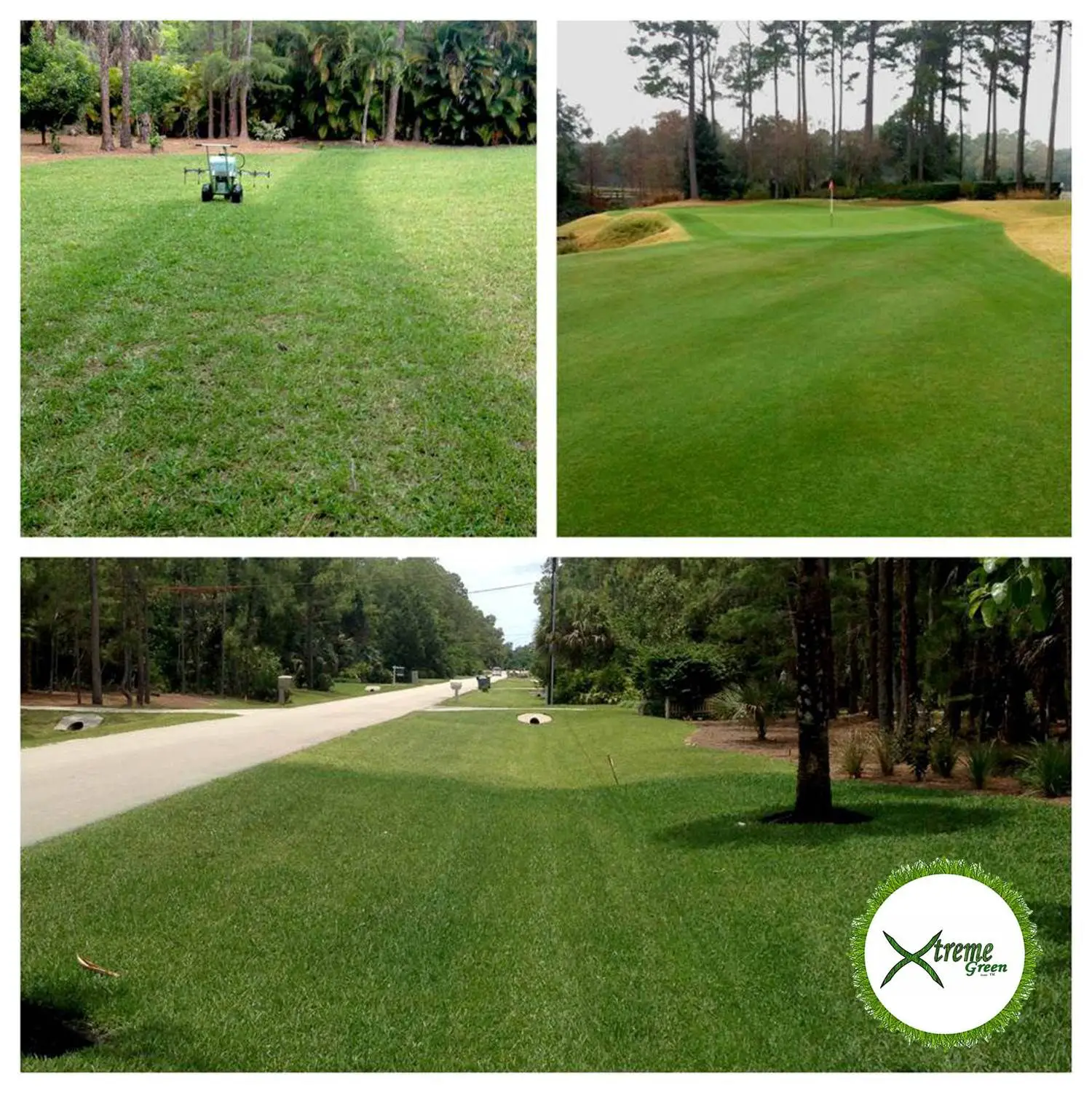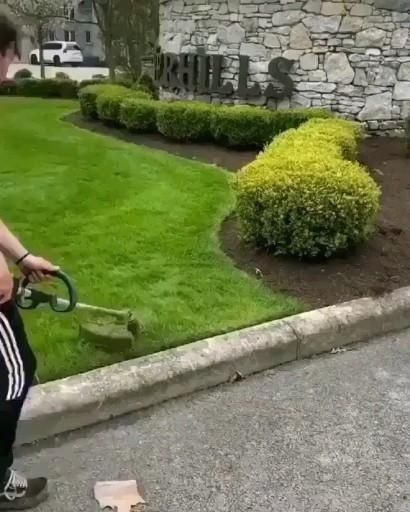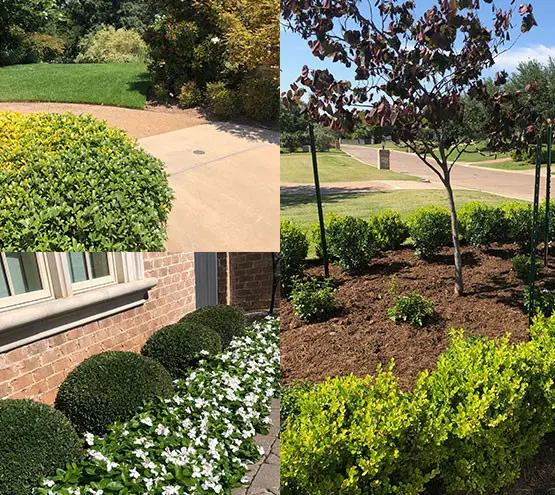Allow The Soil To Breathe
The soil in lawns becomes compacted over time, resulting in weak or dying grass. Aerate your soil with a garden fork or a manual lawn plug aerator. The holes left behind allow the soil to breathe and let water and nutrients reach the grass roots. For a larger area, you may want to rent a gas-powered, walk-behind aerator. Its a good idea to mark any sprinkler lines or electrical wires first, so they dont get cut in the process.
Professional Lawn Care Tips To Try Right Now
Whether you want to implement a few of these strategies or employ all of them, you should see a noticeable result. However, the biggest impact comes from leveraging all 6 of our professional lawn care tips over the course of the year. See what we recommend:
Sharpen Your Mower Blades
One of the simplest things you can do is also the most effective. Whether you have a push or riding mower, make sure to sharpen your mower blades often approximately every 4 months. When the blades are dull, the grass wont be cut cleanly but will instead tear. This can lead to an uneven length and even sections of grass that turn brown.
Aerate Your Lawn
This is a professional lawn care tip that your average homeowner doesnt do, but youre missing the serious advantages if you dont! Aerating a lawn ensures that the grass has ample oxygen to grow its healthiest. In particular, aerating is responsible for creating a lush and green grass color which is why its a part of nearly every professional groundskeepers routine. We recommend aerating your lawn once a month over the summer and twice in the spring, as well as twice in the fall. Buying your own professional-quality aerator is more affordable than most people think our models start between $1,200 and $1,500.
Favor The Use Of Natural Fertilizers
Natural fertilizers such as a kelp meal or compost are better for the environment and your grass. They are also safer and healthier for humans and animals than synthetic fertilizers. At the beginning of the growing season in spring, the lawn needs more nutrients so it is recommended to use a fertilizer that contains nitrogen, potassium, phosphate and magnesium to help the lawn become stronger. The fertilizer should be spread evenly on dry grass after mowing. Once spread, you should water abundantly.
Also Check: Does Home Depot Recycle Old Lawn Mowers
What To Do What Your Lawn Clippings #
Once youve perfected your lawns height, you might be wondering if theres anything practical you can do with your excess clippings. Composting is the perfect solution for any keen gardener to promote grass growth. Simply add your clippings to a compost bin and mix them with a carbon-rich material and wait for them to aerate. Then you can apply the compost to your lawn in hotter months in order to keep the moisture all locked in.
Tip No : Mow Only The Top One

The top one-third of a blade of grass is thin and leafy, decomposes quickly when cut and can contribute up to one-third of the nitrogen your lawn needs . While its decomposing, this light layer of clippings also helps slow water evaporation and keeps weeds from germinating. Check out these handy mowing tips.
But the bottom two-thirds of a blade of grass is tough, stemmy and slow to decompose, contributing to thatch. When thick enough, thatch prevents sunlight, air, water and nutrients from reaching the soil. Cutting more than the top third also shocks grass roots and exposes stems, which tend to burn in direct sunlight.
So if two inches is your target grass height, cut it when it reaches three inches. Since grass grows at different rates at different times of the year, every Saturday isnt necessarily the best time to mow. Sometimes you need to mow it more, other times less. The ideal length for cool-climate grasses is three to four inches for warm-climate, one to two inches.
Mow when the grass is dry and avoid mowing in the heat of the day when youre more likely to stress the grass and yourself.
Family Handyman
Don’t Miss: How To Kill Moles In Lawn
Seed More Than You Would Think
Grass has a hard time throughout the frozen months which is why come spring our lawns never look the same. They have thinned out, have dead spots, and may have receded around the perimeter. Overseeding over top of your existing lawn is a great way to address problem areas and thicken the entirety of your lawn. When it comes to seeding, most think that only addressing areas of concern is enough to replenish the appearance of your lawn. Unfortunately, this can lead to unevenness and unresolved spots throughout. Ensure you are overseeding the entirety of the lawn for maximum growth and preventative measures against weeds.
Early fall and late spring are ideal times to seed your lawn as the soil is warm and the air is cool. During May here in Alberta, the soil has thawed, and the ground begins to warm which is an optimal time for seeding. An additional benefit to spring seeding is the lack of weeds present. Minimal weeds during the spring when seeding helps prevent further intrusion and provides ample time to enjoy your new luxurious lawn.
Water Your Lawn Abundantly And Less Often
If you want to improve your lawns health, it is very important that you water it regularly. The recommended frequency of watering will depend on the grass type and weather. Most lawns need around one inch of water a week, including rainfall. However, this may vary if you live in a hot and dry environment. It is preferable to water less often, but for longer periods of time.
Read Also: How To Promote My Lawn Care Business
Tips For A Better Lawn
You might not know it, but your lawn pays you back for all the hard work you put into it . Your lawn serves as a huge source of air conditioning for your garden, keeping it cool in the hot summer months.
It also releases oxygen and simultaneously captures dust, keeping you and your family healthy. To reap the benefits to the full, keep your lawn as healthy as possible with these handy tips.
Customize Your Grass For Performance
For new properties and areas where the lawn needs a complete overhaul, its possible to customize the type of grass for optimal performance. There are many different grass varieties that are popular for lawns. Some, like Bermuda grass and Kentucky bluegrass, dont require as much maintenance.
Grass varieties also perform differently depending on your regions specific climate and rainfall amounts. Be sure to choose the right grass for your climate zone. A lawn professional can help you with customized recommendations for a new lawn.
Also Check: When Should You Apply Weed Killer To Your Lawn
Patch Treatment For The Perfect Lawn
There are many reasons for patches on lawns including compaction, areas of heavy traffic, pests, patches after killing weeds/moss etc. etc. but if you have brown patches we need to get a lawn repair pack of seed. These again come under many brand names but essentially what you get is a tough lawn seed mix that can be over seeded into the area. You need to slightly till the area, sow the seed and water. Do not mow this area too quickly. Make sure you give it a chance to establish by Keeping all traffic of the lawn.
It is important as I always say to have a healthy lawn with healthy roots and the only way to do this is to follow the maintenance measures mentioned at the start. All of these done consistently over time will ensure your lawn looks in peak condition.
Perfect Lawn Care Tip #: Trim The Hedges
Overgrown trees, shrubs and grass are messy to the eye. You need to trim greenery to keep it looking great. How often you cut the grass and trim hedges/shrubs depends on a few factors. A lot of rain will make greenery grow. But not enough rain could delay growth.
If a lack of rain is drying up your green hues, then you might need to water more frequently. However, if you live in an area of drought, you might be forced to ration water.
Read Also: Which Is Better Gas Or Battery Lawn Mower
Pests And Lawn Disease
No lawn, even the perfect lawn, is immune to pests. Grubs are an especially nuisance to lawns, but keep a look out for dead spots in your yard that could be caused by pests or by a lawn fungus. Also, you can deter moles from your lawn simply by getting rid of their food source in the soilgrubs. If you spot signs of pests or lawn disease, treat them accordingly. Read product labels carefully before you treat your lawn to ensure theyre safe for your grass type. Remember not to water your lawn too frequently as they can leave it vulnerable to disease.
How To Care For Your Lawn

If you have an established lawn, there is that intimidating thing the lawn maintenance programme. Unless you are an organic gardener this will involve applying a weedkiller and fertiliser dressing in spring and again in autumn, as well as a mosskiller. I am organic and rely on a little tool called a daisy grubber to prise out rosette-forming weeds, such as daisies, plantains and dandelions the rest I tolerate. I feed with blood, bone and fishmeal in spring and again in early summer always just before rain. I rake out the moss each spring, just before I feed.
Why dont I use lawn weedkiller? Five years ago, I saw a mother blackbird pulling a worm from a blackened lawn I had just treated with weedkiller and mosskiller, taking it back to feed her young. I have not used weed and feed since. My lawn is still a great backdrop to the rest of the garden.
Above all, mow regularly: once a week between April and September. Once a fortnight is not enough to thicken up the grass. Oh, and the stripes? Youll need a rear roller. For we gardeners, a rotary mower with a rear roller will produce stripes. Cutting down to a height of 1in is low enough and remove and compost the clippings, rather than leaving them to be tramped into the house. And if your garden is too small? Well, there is always plastic grass the modern stuff is hard to tell from the real thing.
This article was originally published in 2015.
Read Also: Is It Too Hot To Fertilize My Lawn
Tip No : A Few Good Soakings Are Better Than Lots Of Light Sprinklings
Deep watering helps develop deep roots that tap into subsurface water supplies . Light sprinklings moisten only the grass and surface of the soil, encouraging shallow root growth and increasing the need for more frequent watering. Lawns generally require 1 to 2 in. of water per week from you or Mother Nature, applied at three- or four-day intervals. But this varies drastically depending on the temperature, type of grass and soil conditions. Lawns in sandy soils may need twice as much water since they drain quickly. Lawns in slow-draining clay soils may need only half as much.
When your lawn loses its bounce or resiliency, or when it wilts, exposing the dull green bottoms of the blades, it needs water. In general, water until the soil is moist four to five inches down, then wait to water again until the top one or two inches dries out. To find out how much water your sprinkler delivers, set out a cake pan, turn on your sprinkler, then time how long it takes for the water to reach a depth of one inch .
The best time of day to water is early morning. Water pressure is high, less water is lost to evaporation and your lawn has plenty of time to dry out before nightfall. Lawns that remain wet overnight are more susceptible to disease caused by moisture-loving mold and other fungi.
Family Handyman
Tips For The Perfect Lawn
Nothing says summer quite like the perfect lawn! Taking care of your lawn isnt hard, but it does require some care, time, and dedication. If youre willing to put in a little extra effort, youll certainly be rewarded with an amazing lawn! One youll be proud to show off and happy to enjoy every single day!
Read on to discover five easy tips to make your lawn perfect.
Recommended Reading: How To Treat Leaf Spot Disease In Lawn
Tip No : With Fertilizers And Weed Killers Timing Is Everything
When applying weed killers and fertilizers, take into account variables like geographic location, grass type, weed type and soil conditions. Here are a few general guidelines:
- A thick, healthy lawn that doesnt provide weed seeds adequate sunlight or open space to germinate is your best defense against weeds. A sick, spotty lawn leaves lots of open space for weeds to take root and grow.
- Attack weeds in the early spring and summer before they have a chance to develop deep root systems, go to seed or reproduce.
- Different weeds require different chemicals and methods. Its best to eradicate grassy weeds like crabgrass with pre-emergent weed killers, which destroy germinating plants as they sprout. Broadleaf weeds need to be attacked while theyre young and actively growing spraying the leaves of individual plants or patches of plants is most effective. Dandelion killers work by literally growing the plant to death.
The best resource for identifying and troubleshooting weeds is a nursery or garden center familiar with local conditions.
Family Handyman
Tips On Maintaining The Perfect Lawn
Showing off a lush, green lawn is possible if you take the time and put in the effort for a solid lawn maintenance routine. Lawn care involves a combination of simple daily and weekly tasks that you can do yourself, or get a little bit of help from a landscaping professional. Our nine tips on maintaining the perfect lawn between landscaper visits will keep you at the top of your lawn game.
Recommended Reading: Are Craftsman Riding Lawn Mowers Good
Perfect Lawn Care: The Lawn Is Flooded
Too little rain can leave your lawn all dried up but too much rain can cause a mess. So what do you do with your lawn if the rain never seems to stop?
Obviously, you cant stop Mother Natures tears. But you can plant a rain garden if you have a sloped lawn. My Fox 8 notes that too much rain can cause fungus to flourishand you may need to use a fungicide. If youre overwhelmed by fungus, and it seems to be spreading, consider calling a lawn care expert.
Becoming An Expert In Having The Perfect Lawn
There is a great set of books called the Expert collection written by Dr.D.G.Hessayon. Im sure many of you would have heard of these. If not they are well worth checking and cover many different topics in gardening. For example the Rose Expert, Tree & Shrub Expert Lawn Expert etc.
The reason I mention this in an episode about lawns. Is that there is a great feature in one of those books The Lawn Expert . Essentially it is a step map which allows you to fully recognise which lawn type you have. Starting in a position and answering a set of yes and no questions. Until you end up at the type of lawn you have.
The book looks at the following topics worn out . First Rate .Broken into First rate luxury & First rate utility. Second rate . The majority of lawns in Ireland and the Uk fall under Second rate. So dont take offence if the answers you give guide you to this lawn type. Essentially what it means is that you fundamentally have a good lawn but it just needs a bit of TLC.
Read Also: How To Bid Lawn Service
Take A Little Off The Top
Adjust the height of the mower’s deck to the top or second-to-top position. Time your mowing so that you remove about one-third of the grass leaves each time you mow. In the early spring that may mean mowing every four or five days. In the summer, once a week should do it. In late summer, you may not need to mow at all if the grass goes dormant and stops growing.
Trimming grass too short lops off much of the energy-producing top growth, resulting in a weak, sickly lawn. Frequent mowing to the correct height also produces tiny grass clippings that can be left on the lawn to decompose and return nutrients back to the soil.
How To Grow The Perfect Lawn: From The Experts

For many people, a beautiful lawn is the finishing touch on their home décor. After all, it makes any house look even better! However, achieving that picture perfect lawn takes careful work, a strategy, and the right equipment. In todays blog, were exploring how to grow the perfect lawn one whose color and fullness will turn heads.
At TurfTime, we build ground maintenance equipment used everywhere from homes to the largest golf courses and athletic fields in the country. Our clients depend on our equipment to grow the healthiest grass that looks good enough to be seen by millions on HD televisions all across the country. Were sharing our expert tips specifically for homes to help teach you how to grow the perfect lawn.
You May Like: How To Rid Lawn Of Clover
